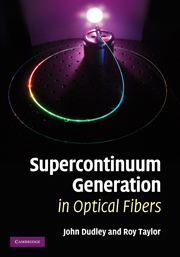Book contents
- Frontmatter
- Contents
- List of contributors
- Preface
- 1 Introduction and history
- 2 Supercontinuum generation in microstructure fibers – a historical note
- 3 Nonlinear fibre optics overview
- 4 Fibre supercontinuum generation overview
- 5 Silica fibres for supercontinuum generation
- 6 Supercontinuum generation and nonlinearity in soft glass fibres
- 7 Increasing the blue-shift of a picosecond pumped supercontinuum
- 8 Continuous wave supercontinuum generation
- 9 Theory of supercontinuum and interaction of solitons with dispersive waves
- 10 Interaction of four-wave mixing and stimulated Raman scattering in optical fibers
- 11 Nonlinear optics in emerging waveguides: revised fundamentals and implications
- 12 Supercontinuum generation in dispersion-varying fibers
- 13 Supercontinuum generation in chalcogenide glass waveguides
- 14 Supercontinuum generation for carrier-envelope phase stabilization of mode-locked lasers
- 15 Biophotonics applications of supercontinuum generation
- 16 Fiber sources of tailored supercontinuum in nonlinear microspectroscopy and imaging
- Index
1 - Introduction and history
Published online by Cambridge University Press: 06 July 2010
- Frontmatter
- Contents
- List of contributors
- Preface
- 1 Introduction and history
- 2 Supercontinuum generation in microstructure fibers – a historical note
- 3 Nonlinear fibre optics overview
- 4 Fibre supercontinuum generation overview
- 5 Silica fibres for supercontinuum generation
- 6 Supercontinuum generation and nonlinearity in soft glass fibres
- 7 Increasing the blue-shift of a picosecond pumped supercontinuum
- 8 Continuous wave supercontinuum generation
- 9 Theory of supercontinuum and interaction of solitons with dispersive waves
- 10 Interaction of four-wave mixing and stimulated Raman scattering in optical fibers
- 11 Nonlinear optics in emerging waveguides: revised fundamentals and implications
- 12 Supercontinuum generation in dispersion-varying fibers
- 13 Supercontinuum generation in chalcogenide glass waveguides
- 14 Supercontinuum generation for carrier-envelope phase stabilization of mode-locked lasers
- 15 Biophotonics applications of supercontinuum generation
- 16 Fiber sources of tailored supercontinuum in nonlinear microspectroscopy and imaging
- Index
Summary
With the invention of the laser (Maiman 1960), rapid technological development of Q-switching (McClung and Hellwarth 1962) and mode locking techniques (Mocker and Collins 1965, DeMaria et al. 1966) allowed the achievement of the shortest, controllable, man-made pulse durations, and, consequently, for even modest pulse energies, unprecedented optical peak powers were achievable with ever-decreasing pulse durations, establishing a trend which continues to the present day. The enormous optical field strengths generated at the focal point of a pulsed laser ensured that the corresponding electronic polarization response of a transparent medium was nonlinear, in that higher order terms of the expansion describing the polarization needed to be considered despite the then insignificance of the magnitude of the second and third order susceptibilities and as a consequence ushered in the era of nonlinear optics. The first nonlinear optical process to be reported was second harmonic generation (Franken et al. 1961), which although observable, is of little importance in relation to the subject matter of this book, supercontinuum generation in optical fibres. However, this was followed by reports of frequency mixing (Bass et al. 1962) and parametric generation (Giordmaine and Miller 1965, Akhmanov et al. 1965). Essential for supercontinuum generation are the processes that result from the third order nonlinear term (Maker and Terhune 1965).
- Type
- Chapter
- Information
- Supercontinuum Generation in Optical Fibers , pp. 1 - 29Publisher: Cambridge University PressPrint publication year: 2010

